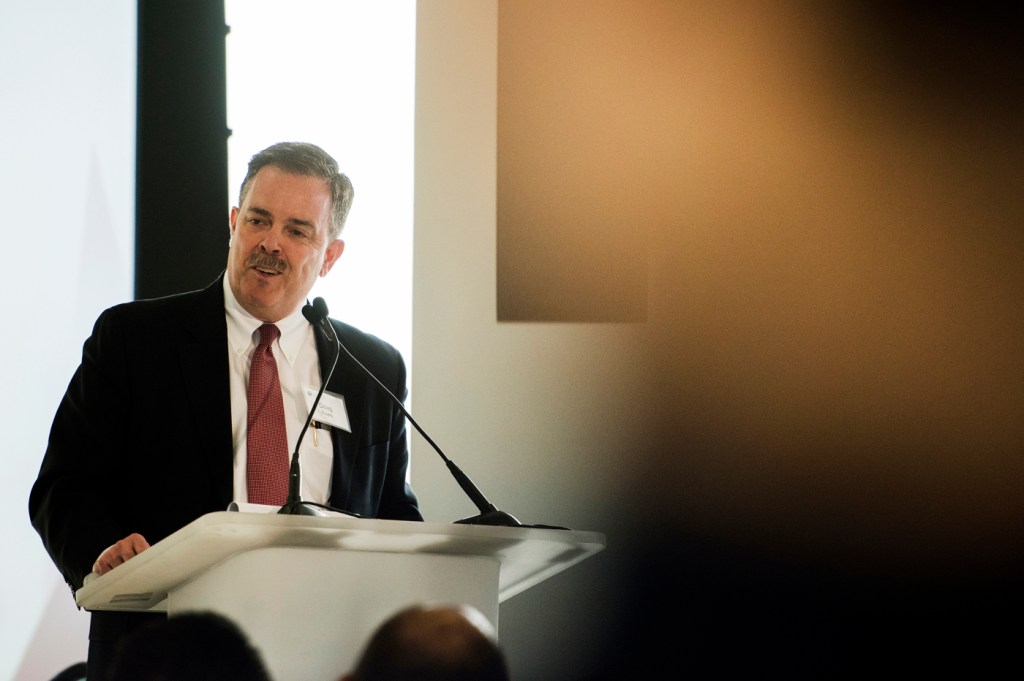Global disaster response needs a networked approach

“Pray with me.”
A homeless boy from Puerto Rico said those words as presidential advisor Doug Fears and other officials prepared to board a helicopter to leave the mountain town of Utuado in the aftermath of Hurricane Irma.
The September 2017 storm had caused $1 billion in damage, wiping out all communication, and leaving 1 million people without power or water.
“Landing on the island was like being taken back to the year 1880,” Fears told an audience of 200 people at the inaugural Global Resilience Research Network Summit on Thursday hosted by Northeastern’s Global Resilience Institute. “We will be working through this recovery for at least a decade.”
Fears choked up as he described the boy’s plea.
But the institute’s director, Stephen Flynn, intends to do a lot more than pray.
He organized the summit—which featured 24 speakers from 14 countries—to convene a worldwide network of experts whose mission is to devise more effective ways to respond to and rebound from disaster. The summit brought together leaders from major universities and research institutes around the globe to share expertise and forge collaborative efforts to meet the world’s most daunting resilience challenges.
“As our world becomes more connected, we also become more interdependent—and any shock will have a much wider effect,” said Flynn in his opening remarks in the 17th floor conference area in East Village.
The conference focused on four areas of resilience: public awareness, system design, incentives, and governance.
As our world becomes more connected, we also become more interdependent—and any shock will have a much wider effect.
Stephen Flynn, Professor and director of the Global Resilience Institute
“We are not presently organized to take a networked approach to these challenges,” said Flynn.
The pace of disasters is quickening, according to Fears, who serves as the senior director of resilience policy at the National Security Council. He noted that 2017 was a year of record-breaking hurricanes, wildfires, and floods, which touched the lives of 8 percent of all Americans and caused $300 billion in damage.
He said that while investment in resilience is expensive, it’s not nearly as expensive as failing to do so.
“For every dollar spent on mitigation, we save somewhere between $3 and $8 on disaster recovery,” said Fears. “So even if you use the lowest number, resilience spending could have saved us $200 billion last year.”
Harris County Judge Ed Emmett has led the response and recovery from one of the worst of those disasters—the Texas floods of 2017. Over the course of four days in August, Hurricane Harvey dumped 50 inches of rain, submerging large portions of Houston and the surrounding communities. With transportation cut off, Emmett had to enlist private citizens to rescue people from their flooded homes.
“Houston looked like the evacuation of Dunkirk, with a fleet of citizen boats bringing people to safety, “ he said.
Emmett, the county’s top elected official, noted that Harvey was the third 500-year flood to hit Houston in the past three years. “So either we’re all set for the next 1,500 years, or things are changing and we need to rethink the way we are doing things,” he said.
He said the first step is to admit the mistakes that have been made. For example, Houston built a flood containment system with walls and low-lying catchment areas to gather floodwater. But because the city has no zoning laws, developers built neighborhoods right in the flood basins. Needless to say, that made the disaster even worse.
One of Emmett’s first post-disaster actions was to propose new zoning laws that prohibit similar development in the future.
“The time to make major changes is immediately,” he said. “You need to act while there’s a strong will to change. We had no pushback to our proposal, but if we had waited, it would have been much harder.”
Emmett also developed a registry of the elderly and people with disabilities who need assistance to evacuate in advance of a disaster. And since a strong citizen response is a key component of community resilience, he developed a Community Emergency Response Team in Harris County, a national program that has more than 30,000 citizen volunteers who have been trained in medical and rescue skills.
Trust is a particularly important element of resilience in many parts of the world, according to Kuntoro Mangkusubroto of Indonesia. When a massive tsunami hit the island of Sumatra in 2004, it wiped out more than 400 miles of coastline in 10 minutes, leaving more than 200,000 dead and 500,000 homeless.
Yet relief efforts had a slow start because there was widespread distrust of both the government and the military. The solution was to establish a quasi government with a civilian at its head—Mangkusubroto.
“I was in charge and I was not a politician or a bureaucrat,” he said. “I was a private citizen.”
One of the first things he did was establish a four-year term limit for himself, because he believed that individual community resilience is essential.
“Without that limit, people would have begun to rely on assistance,” he said. “I told them, we will fix your bridges, and your hospitals and your water supplies, but after four years, if you have complaints, complain to yourselves.”
The importance of public engagement was a consistent theme of the conference. Gonzalo Bacigalupe of Chile described how he teaches citizens to fly drones as a way to get them interested in the geography of their communities. Northeastern professor Brian Helmuth described how his marine science team is developing simulation games in which citizens explore the unexpected consequences of various response priorities.
“We need to learn how to set priorities and how to get all the benefits of being connected while minimizing the risks,” said Flynn. “The word for today is urgent. The race is on.”





